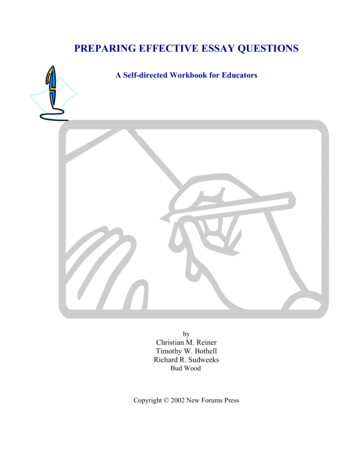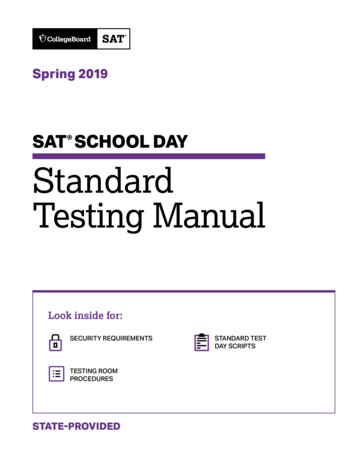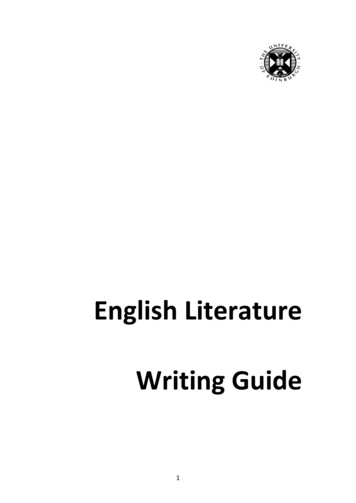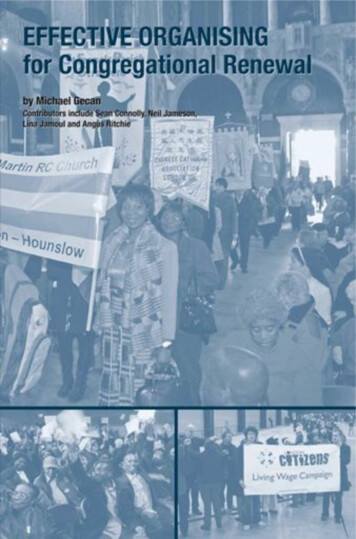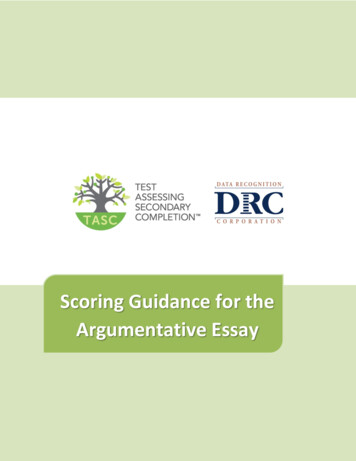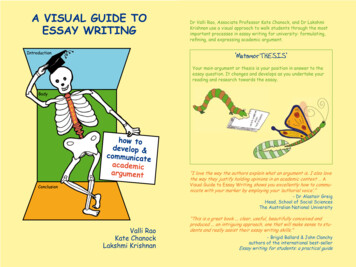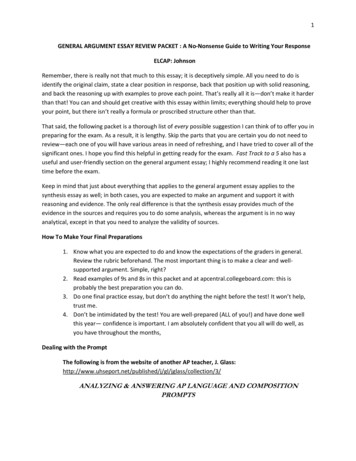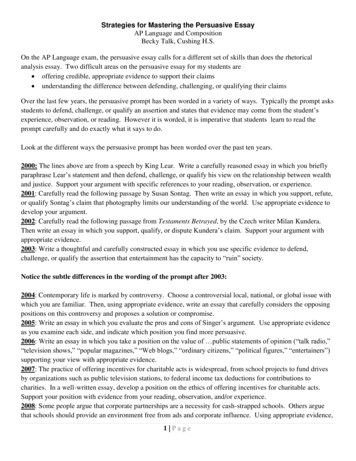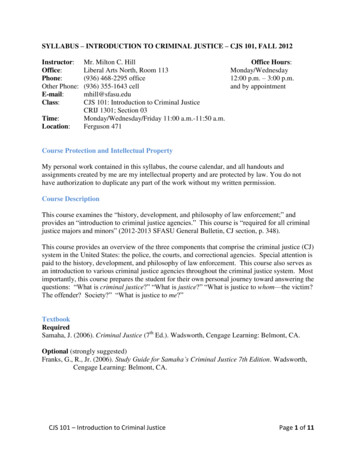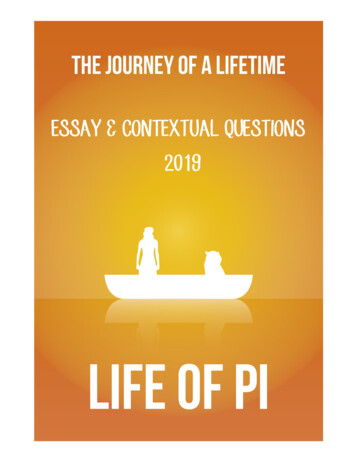
Transcription
ESSAY & CONTEXTUAL QUESTIONS2019
Author’s Note1. What is suggested by the author’s comment about fiction being “the selective transforming ofreality? The twisting of it to bring out its essence”?2. Why did the author go to India?3. Why does the author mail his manuscript for the book about Portugal to a made-up address inSiberia?4. Who first tells the author about Mr. Patel’s story? How many storytellers does this make in thebook so far?5. What is most significant about the story that the author hears?EXTRACT A:He took in my line of work with a widening of the eyes and a nodding of the head. It was time to go. I had myhand up, trying to catch my waiter’s eye to get the bill.Then the elderly man said, “I have a story that will make you believe in God.”I stopped waving my hand. But I was suspicious. Was this a Jehovah’s Witness knocking at my door? “Doesyour story take place two thousand years ago in a remote corner of the Roman Empire?” I asked.“No.”Was he some sort of Muslim evangelist? “Does it take place in seventh-century Arabia?”“No, no. It starts right here in Pondicherry just a few years back, and it ends, I am delighted to tell you, in thevery country you come from.”“And it will make me believe in God?”“Yes.”“That’s a tall order.”“Not so tall that you can’t reach.”My waiter appeared. I hesitated for a moment. I ordered two coffees. We introduced ourselves. His name wasFrancis Adirubasamy.“Please tell me your story,” I said.“You must pay proper attention,” he replied.“I will.” I brought out pen and notepad.“Tell me, have you been to the botanical garden?” he asked.“I went yesterday.”“Did you notice the toy train tracks?”“Yes, I did.”“A train still runs on Sundays for the amusement of the children. But it used to run twice an hour every day. Didyou take note of the names of the stations?”“One is called Roseville. It’s right next to the rose garden.”“That’s right. And the other?”“I don’t remember.”“The sign was taken down. TH other station was once called Zootown. They toy train had two stops: Rosevilleand Zootown. Once upon a time there was a zoon in Pondicherry Botanical Garden.”1 Life of Pi Ques tion Book
1.2.3.4.5.6.7.8.Place this passage in context by describing where the Author/narrator is and why he isthere.a) State the Auhtor/narrator’s line of work.b) What does the widening of Mr Adirubasamy’s eyes suggest to the Author/narratorabout his listener’s opinion of his profession?c) Is the Author/narrator’s interpretation of Mr Adirubasamy’s opinion of his professioncorrect? Give a reason for your answer.Compare the Author/narrator’s religious beliefs to those of Mr Adirubasamy. Support youranswer by quoting from the passage.The Author/narrator refers to Christianity (“two thousand years ago”) and Islam (“seventhcentury/Arabia”) as though they are two entirely separate belief systems. How does thiscontrast to Pi’s beliefs depicted in the novel as a whole?Using what you know about Mr Adirubasamy’s role in Pi’s life, explain why it is fitting thathe be the one to lead the Author/narrator to Pi.“Once upon a time there was a zoo ”Explain how this statement introduces the novel’s important theme of storytelling and thelistener/reader’s belief in these stories.What is the outcome of this encounter between the Author/narrator and Mr Adirubasamy?Why do you think the Author/narrator has included this encounter in the Author’s note?(3)(1)(2)(3)(4)(2)(3)(4)(2)(1)Part One: Toronto and PondicherryChapter 11. What is suggested by the fact that the Author’s note was set in italics, and Chapter 1 is set innormal text?2. Who do we assume is the speaker of Chapter 1? What suggests this?3. Why did the person speaking in Chapter 1 choose to study the sloth?4. What we can infer about Mr. Patel from his tone?5. What is significant about the cities Mr. Patel says he would like to visit?6. What were Mr. Patel’s two majors in college? What connection does he make between thetwo? How do they foreshadow what is likely to come later in the novel?7. What can we infer about the narrator so far?Chapter 21. What do the language and format of this chapter establish for the reader?2. What is significant about the details the fictional author chooses to reveal about Mr. Patel?Chapter 31. What might the origin of Patel’s name foreshadow?2. What significant trait did the narrator and Mamaji share?3. Who is the man Patel calls Mamaji, who teaches Patel how to swim? How have we alreadymet him?4. What does the name “Mamaji” mean?5. What distinction does Mr. Patel make between the ocean and the swimming pool? What is thesignificance of this distinction?6. In this chapter, we finally learn the full name of our narrator. What is it and how did he get it?2 Life of Pi Ques tion Book
7. What is significant about the narrator’s name?8. What did Piscine’s father do for a living?Chapter 41. What did Piscine’s father do before he became a zookeeper? What comment does Piscinemake about the transition from hotel owner to zookeeper?2. How does Pi feel about growing up in a zoo? In terms of the Bildungsroman narrative, whatmight the zoo symbolize?3. What is Piscine implying when he says that the only “relentless imperatives” felt by animals isavoiding enemies and securing food and water?4. What is Piscine implying when he says that “a house is compressed territory, where our basicneeds can be fulfilled close by and safely”?5. Does Piscine believe animals are better off in the wild or in a zoo?6. What comparison does the adult Piscine make between the impulse to “free” animals andinvading a person’s home and “freeing” him? Why is this comparison significant?7. What does Pi mean when he says that “certain illusions about freedom plague” both zoos andreligion?Chapter 51. What might be significant about the name Pi chooses for himself?2. What does Pi mean at the end of this chapter when he says, “in that elusive, irrational numberwith which scientists try to understand the universe, I found refuge.”3. What personal characteristics does Pi exhibit in choosing to change his own name?EXTRACT B:I repeated the stunt with every teacher. Repetition is important in the training not only of animals but also ofhumans. Between one commonly named boy and the next, I rushed forward and emblazoned, sometimes witha terrible screech, the details of my rebirth. It got to be that after a few times the boys sang along with me, acrescendo that climaxed, after a quick intake of air while I underlined the proper note, with such a rousingrendition of my new name that it would have been the delight of any choirmaster. A few boys followed up with awhispered, urgent “Three! Point! One! Four!” as I wrote as fast as I could, and I ended the concert by slicingthe circle with such vigour that bits of chalk went flying.When I put my hand up that day, which I did every chance I had, teachers granted me the right to speak with asingle syllable that was music to my ears. Students followed suit. Even the St Joseph’s devils. In fact, thename caught on. Truly we are a nation of aspiring engineers: shortly after, there was a boy named Omprakashwho was calling himself Omega, and another who was passing himself off as Upsilon, and for a while therewas a Gamma, a Lambda and a Delta. But I was the first and the most enduring of the Greeks at PetitSeminaire. Even my brother, the captain of the cricket team, that local god, approved. He took me aside thenext week.“What’s this I hear about a nickname you have” he said.I kept silent. Because whatever mocking was to come, it was to come. There was no avoiding it."I didn't realize you liked the colour yellow so much."3 Life of Pi Ques tion Book
The colour yellow? I looked around. No one must hear what he was about to say, especially not one of hislackeys. "Ravi, what do you mean?" I whispered."It's all right with me, brother. Anything's better than 'Pissing'. Even 'Lemon Pie'."As he sauntered away he smiled and said, "You look a bit red in the face."But he held his peace.And so, in that Greek letter that looks like a shack with a corrugated tin roof, in that elusive, irrational numberwith which scientists try to understand the universe, I found refuge.Describe the “stunt” to which Pi is referring.“Repetition is important in the training of animals but also of humans.”a) State the reason Pi knows so much about the training of animals.b) Explain fully how his knowledge of training animals later saves Pi’s life.c) In your view, is Pi suggesting that humans and animals are similar in some respects?Substantiate your response.a) What does Pi mean by “commonly named boy” in the context of the setting of thissection of the novel?b) State why Pi is not a “commonly named boy” with reference to his full name.”“the details of my rebirth”Why did Pi feel that this “rebirth” was necessary?“we are a nation of aspiring engineers”Explain why Pi makes this statement.Identify the reason that Ravi is described as a “local god”.What does Ravi’s conversation with Pi reveal about his relationship with Pi?Pi is described as an “irrational number with which scientists try to understand theuniverse”. Critically discuss why this statement can be said to be paradoxical.1.2.3.4.5.6.7.8.Chapter 61. What does the author’s description of Patel’s kitchen suggest?Chapter 71.2.3.4.5.6.7.What language and imagery does Pi use to describe Mr. Kumar? Why is it significant?Why does Mr. Kumar love the zoo?What does the zoo represent to Mr. Kumar?Why does Mr. Kumar not believe in God?Why doesn’t Pi argue with Mr. Kumar about the existence of God?How are atheists like believers, according to Pi?What problem does Pi have with agnostics?Chapter 81. Why do zoologists “commonly say that the most dangerous animal in a zoo is man”?2. What animal does Pi’s father believe is “even more dangerous than us”?4 Life of Pi Ques tion Book(3)(1)(3)(2)(2)(2)(3)(2)(1)(3)(3)
3. What does Pi mean when he says, “The obsession with putting ourselves at the center ofeverything is the bane not only of theologists but also of zoologists”?4. What is the point of the episode Pi relates about the ravenous tiger and the goat? Why hasMartel placed this episode in the same chapter with the discussion of anthropomorphism?What might this episode foreshadow?EXTRACT C:Just beyond the ticket booth Father had painted on a wall in bright red letters the question: DO YOU KNOWWHICH IS THE MOST DANGEROUS ANIMAL IN THE ZOO? An arrow pointed to a small curtain. There wereso many eager, curious hands that pulled at the curtain that we had to replace it regularly. Behind it was amirror.But I learned at my expense that Father believed there was another animal even more dangerous than us, andone that was extremely common, too, found on every continent, in every habitat: the redoubtable speciesAnimalus anthropomorphicus, the animal as seen through human eyes. We've all met one, perhaps evenowned one. It is an animal that is "cute", "friendly", "loving", "devoted", "merry", "understanding". Theseanimals lie in ambush in every toy store and children's zoo. Countless stories are told of them. They are thependants of those "vicious", "bloodthirsty", "depraved" animals that inflame the ire of the maniacs I have justmentioned, who vent their spite on them with walking sticks and umbrellas. In both cases we look at an animaland see a mirror. The obsession with putting ourselves at the centre of everything is the bane not only oftheologians but also of zoologists.I learned the lesson that an animal is an animal, essentially and practically removed from us, twice: once withFather and once with Richard Parker.1.2.3.4.5.6.7.a) List the techniques Pi’s father uses to draw the zoo visitors’ attention to the mirror.b) How do we know the techniques are successful?Using your knowledge of the novel, summarise three points that Pi makes earlier whichdemonstrate that humans are indeed the most dangerous animals in the zoo.Use your own words to explain what Animalus anthromorphicus means.Comment on why the words “cute”, “friendly”, “devoted” and so on are written in invertedcommas.According to Pi, why do some people attack certain animals in the zoo with walking sticksand umbrellas?“In both cases, we look at an animal and see a mirror.”a) Comment critically on what Pi is inferring about people with the use of “in bothcases”.b) Provide evidence from the second story that Pi tells the Japanese investigators thatsubstantiates Pi’s argument above. Your evidence should include a briefexplanation of how the people on the boat exemplify “both cases.”“I learned the lesson that an animal is an animal.”a) Describe how Pi’s father goes about teaching Pi and Ravi this lesson.b) Why does he teach them this lesson?c) What does this lesson show us about the kind of father he is?d) Critically discuss how this lesson relates to the theme of anthropomorphism.Chapter 91. What is a “flight distance”?5 Life of Pi Ques tion Book(3)(1)(3)(1)(2)(2)(2)(4)(1)(1)(2)(3)
2. Why is an understanding of animals’ flight distance important to a zookeeper?Chapter 101. What are some of the reasons Pi gives for animals’ wanting to escape from zoos?2. Why does Pi goes into such detail explaining how zoos work?3. What, according to Pi, does “an animal hate above all else”?Chapter 111. What happened to the leopard that escaped from a zoo in Zurich in the 1930s, and what doesthe story illustrate?2. What might Pi mean by the following: “And they expected to find—ha! In the middle of aMexican tropical jungle, imagine!”Chapter 121. What does the narrator’s saying that Pi Patel “bobs” on the “ocean of memory” foreshadow?2. Who is Richard Parker who “preys on [Pi Patel’s] mind”?Chapter 131. Why is Mr. Patel still spending so much time discussing animal behavior and how humans gain“control” over dangerous wild animals?2. Why is social hierarchy important to animals? What does this have to do with the story Mr.Patel is going to tell the narrator?Chapter 141. Why is the animal with the “lowest social standing” also the easiest to train?Chapter 151. What can be inferred from the religious artifacts that the author sees in Patel’s house about theperson who lives in that house?2. What is the tone of his language as he describes the religious objects?Chapter 161.2.3.4.Explain Pi’s concept of the Brahman nirguna.What is Brahman saguna?What does Pi say made him a Hindu?What is the point of Pi’s tale of Krishna and the milkmaids?Chapter 171. What confuses Pi about Christianity?6 Life of Pi Ques tion Book
2. According to Father Martin, what is the key to the entire Christian story?3. What does Pi like most about Christianity? How does he compare it to his own Hinduism?Chapter 181. Compare the ways Pi comes to know Hinduism, Christianity, and Islam.2. What first impresses Pi about Islam?Chapter 191. Why does Piscine like praying in the mosque?2. What, then, do each of Pi’s three religions give to him?Chapter 201. What is ironic about the Muslim baker’s name? What is Martel suggesting by naming him this?2. What two intensely religious experiences does Pi describe in this chapter? Why are theysignificant?Chapter 211. What impact is his growing friendship with Mr. Patel having on the fictional author?2. What do the phrases, “dry, yeastless factuality” and “the better story” suggest?Chapters 22 – 231. The second speaker in Chapter 22 says he “can well imagine an atheist’s last words: “White,white! L-L-Love! My God!” Why does he think that these would be the last words an atheistwould utter before death?2. To whom does Pi refer when he speaks of “the (three) wise men”?3. What is Pi’s father’s attitude toward religion?4. What is ironic about the meeting of the three religious men?5. Briefly outline each religious man’s argument against the other two religions. What is the pointof this scene?6. What is the power of Pi’s response to the competing religious men?7. On what kind of note does this chapter end?EXTRACT D:It was hard to tell whose face was more inflamed. It looked as if might come to blows.Father raised his hands. "Gentlemen, gentlemen, please!" he interjected. "I would like to remind you there isfreedom of practice in this country."Three apoplectic faces turned to him."Yes! Practice-singular!" the wise men screamed in unison. Three index fingers, like punctuation marks,jumped to attention in the air to emphasize their point.They were not pleased at the unintended choral effect or the spontaneous unity of their gestures. Their fingerscame down quickly, and they sighed and groaned each on his own. Father and Mother stared on, at a loss forwords.7 Life of Pi Ques tion Book
The pandit spoke first. "Mr. Patel, Piscine's piety is admirable. In these troubled times it's good to see a boy sokeen on God. We all agree on that." The imam and the priest nodded. "But he can't be a Hindu, a Christianand a Muslim. It's impossible. He must choose.""I don't think it's a crime, but I suppose you're right," Father replied.The three murmured agreement and looked heavenward, as did Father, whence they felt the decision mustcome. Mother looked at me.A silence fell heavily on my shoulders."Hmmm, Piscine?" Mother nudged me. "How do you feel about the question?""Bapu Gandhi said, 'All religions are true.' I just want to love God," I blurted out, and looked down, red in theface.My embarrassment was contagious. No one said anything. It happened that we were not far from the statue ofGandhi on the esplanade. Stick in hand, an impish smile on his lips, a twinkle in his eyes, the Mahatmawalked. I fancy that he heard our conversation, but that he paid even greater attention to my heart. Fathercleared his throat and said in a half-voice, "I suppose that's what we're all trying to do-love God."I thought it very funny that he should say that, he who hadn't stepped into a temple with a serious intent since Ihad had the faculty of memory. But it seemed to do the trick. You can't reprimand a boy for wanting to loveGod. The three wise men pulled away with stiff, grudging smiles on their faces.Father looked at me for a second, as if to speak, then thought better, said, "Ice cream, anyone?" and headedfor the closest ice cream wallah before we answer. Mother gazed at me a little longer, with an expression thatwas both tender and perplexed.1.Quote two separate words from the first three paragraphs that show that the three menare very angry.2. Explain what Pi’s father means when he says, “there is freedom of practice in this country”3. In light of the theme of faith, what is Pi’s possible motivation for calling these three men“the wise men”?4. a) Name the figure of speech in “like punctuation marks”.b) How does this figure of speech affect your understanding of the three men’sstatements?5. Pi says that the men act “in unison”, with “choral effect” and “spontaneous unity of theirgestures”. Discuss what this observation of Pi’s shows about the three men.6. “But he can’t be a Hindu, a Christian and a Muslim. It’s impossible. He must choose.”Compare the three wise men’s views on religion to Pi’s.7. “I don’t think it’s a crime, but I suppose you are right”Describe Pi’s father’s views on religion.8. What does Pi’s mother’s response to the situation show about her in the context of theuniversal values we associate with mothers?9. State why Pi refers to Bapu Ghandi at this point.10. Relate to how Pi’s father resolves the pters 24 – 251. Why does Yann Martel make this chapter about Ravi’s teasing Pi so short, with so relativelyfew examples and a general dismissal at the end?8 Life of Pi Ques tion Book
2. What ironies does Pi point out in this chapter?Chapter 261. What is the primary conflict in this chapter, represented by Pi, his father, and his mother?2. What is it that causes Pi’s mother to look weary and to sigh, “Good grief” by the end of thischapter?Chapter 271. In addition to religion, what outside influence begins to impose itself on Pi’s family in thischapter? What plot event is clearly foreshadowed? 2. What biological theory does Mr. Patel’sattitude toward technology resemble? Why is this significant?Chapters 28 – 291. To what does Pi compare his baptism—being sprinkled with a beaker-full of water?2. What causes the Patel family to leave India?3. Why does Pi make a point of telling us the animals’ reactions to the political situation in India?Chapter 301. What is the surprise that Pi has for the writer at his home?2. Why has Pi not mentioned that he is married?3. What does Pi’s wife do for a living?Chapters 31 – 321. What is the significance of the meeting of the two Mr. Kumars?2. What point(s) is Pi establishing with his accounts of zoomorphism and unusual cohabitations ofprey and predator?3. Why does zoomorphism occur? What does Pi’s explanation foreshadow?Chapters 33 – 341. What is suggested by Pi’s telling the author that everything from before the family’s emigrationwas “lost”?2. What do we learn about Richard Parker from the photograph that Pi shows the author?3. What is, ironically, the difference between the author’s account (in italics) and Pi’s?Chapter 351. How old is Pi when he and his family embark for Canada?2. Why is the real reason Pi’s mother worries about the brand names of items available inCanada? How does this advance a theme that has already been suggested?Chapter 369 Life of Pi Ques tion Book
1. What surprises the narrator in this chapter?2. Upon meeting Pi’s son and daughter, the writer says that “this story has a happy ending.” Whydoes the writer need to say this?Part Two: The Pacific OceanChapters 37 – 381. How does Yann Martel begin this section of the novel on a surprising and suspenseful note?2. What important part of the plot does Chapter 38 provide?3. What does Pi mean when he says, “the ship vanished into a pinprick hole on my map”?4. How does Martel manage to provide a note of humor even during this tense and suspensefulepisode?EXTRACT E:The ship sank. It made a sound like a monstrous metallic burp. Things bubbled at the surface and thenvanished. Everything was screaming: the sea, the wind, my heart. From the lifeboat I saw something in thewater.I cried, "Richard Parker, is that you? It's so hard to see. Oh, that this rain would stop! Richard Parker? RichardParker? Yes, it is you!"I could see his head. He was struggling to stay at the surface of the water."Jesus, Mary, Muhammad and Vishnu, how good to see you, Richard Parker! Don't give up, please. Come tothe lifeboat. Do you hear this whistle? TREEEEEE! TREEEEEE! TREEEEEE! You heard right. Swim, swim!You're a strong swimmer. It's not a hundred feet."He had seen me. He looked panic-stricken. He started swimming my way. The water about him was shiftingwildly. He looked small and helpless."Richard Parker, can you believe what has happened to us? Tell me it's a bad dream. Tell me it's not real. Tellme I'm still in my bunk on the Tsimtsum and I'm tossing and turning and soon I'll wake up from this nightmare.Tell me I'm still happy. Mother, my tender guardian angel of wisdom, where are you? And you, Father, myloving worrywart? And you, Ravi, dazzling hero of my childhood? Vishnu preserve me, Allah protect me, Christsave me, I can't bear it! TREEEEEE! TREEEEEE! TREEEEEE!"1.2.3.4.5.6.Describe the difference in tone between sentence one and sentence two of the extract.“like a monstrous metallic burp”a) Identify the figure of speech above.b) Identify the phonic device above.c) What is the combined effect of this figure of speech and this phonic device?How does Pi’s use of hyperbole in “Everything was screaming: the sea, the wind, my heart”affect your understanding of his emotions at the time?Explain why Pi refers to “Jesus, Mary, Muhammad and Vishnu” when he sees RichardParker.Who is Richard Parker and how did he get his name?a) Quote from this passage to prove that Pi deliberately makes the listener believe thatRichard Parker is a person without explicitly stating that he is not human.10 L i f e o f P i Q u e s t i o n B o o k(2)(1)(1)(3)(2)(2)(2)(1)
7.b) To which important theme of the novel does this purposeful ambivalence link?Bearing in mind the second story that Pi later tells the Japanese investigators, comment onwhy Pi is so desperate for Richard Parker to make it to the lifeboat.“You’re a strong swimmer.”a) With regards to the first story that Pi tells the investigators, why is it true that RichardParker is a strong swimmer?b) With regards to the second story that Pi tells the investigators, why is it true thatRichard Parker is a strong swimmer?9. Pi asks Richard Parker to tell him that what has happened is “not real”. Critically discussthe use of this phrase in the context of the novel as a whole.10. List two techniques that Pi uses to heighten the tension in the last paragraph of thisexcerpt.(1)(2)8.(1)(1)(4)(2)Chapters 39 – 401. How is Pi’s survival more an act of Providence than human action?2. How does Pi’s survival illustrate his belief in the triumph of faith over reason?Chapter 411. How again does Pi attribute his survival more to Providence than human action?2. How has Martel prepared the reader for the situation in the life boat?3. Why does Pi conclude the sailors threw him overboard into the lifeboat?4. Why is it fortunate for Pi that the hyena is in the lifeboat?Chapter 421. With what significant imagery and symbolism does Pi describe the arrival of Orange Juice, theOrangutan?2. How does he continue to describe the orangutan herself?Chapter 431. Why is Pi so confident that he will be rescued? What does this reveal about his personality?2. How does Pi characterize the hyena?3. What surprising fact about the hyena does Pi share?EXTRACT F:Yet every time the hyena paused at the stern bench, my heart jumped. And as much as I wanted to direct myattention to the horizon, to where my salvation lay, it kept straying back to this maniacal beast.I am not one to hold a prejudice against any animal, but it is a plain fact that the spotted hyena is not wellserved by its appearance. It is ugly beyond redemption. Its thick neck and high shoulders that slope to thehindquarters look as if they've come from a discarded prototype for the giraffe, and its shaggy, coarse coatseems to have been patched together from the leftovers of creation. The colour is a bungled mix of tan, black,yellow, grey, with the spots having none of the classy ostentation of a leopard's rosettes; they look rather likethe symptoms of a skin disease, a virulent form of mange. The head is broad and too massive, with a highforehead, like that of a bear, but suffering from a receding hairline, and with ears that look ridiculously mouselike, large and round, when they haven't been torn off in battle. The mouth is forever open and panting.11 L i f e o f P i Q u e s t i o n B o o k
The nostrils are too big. The tail is scraggly and unwagging. The gait is shambling. All the parts put togetherlook doglike, but like no dog anyone would want as a pet.But I had not forgotten Father's words. These were not cowardly carrion-eaters. If National Geographicportrayed them as such, it was because National Geographic filmed during the day. It is when the moon risesthat the hyena's day starts, and it proves to be a devastating hunter. Hyenas attack in packs whatever animalcan be run down, its flanks opened while still in full motion. They go for zebras, gnus and water buffaloes, andnot only the old or the infirm in a herd-full-grown members too. They are hardy attackers, rising up frombuttings and kickings immediately, never giving up for simple lack of will. And they are clever; anything that canbe distracted from its mother is good. The ten-minute-old gnu is a favourite dish, but hyenas also eat younglions and young rhinoceros. They are diligent when their efforts are rewarded. In fifteen minutes flat, all that willbe left of a zebra is the skull, which may yet be dragged away and gnawed down at leisure by young ones inthe lair. Nothing goes to waste; even grass upon which blood has been spilt will be eaten.Hyenas' stomachs swell visibly as they swallow huge chunks of kill. If they are lucky, they become so full theyhave difficulty moving. Once they've digested their kill, they cough up dense hairballs, which they pick clean ofedibles before rolling in them. Accidental cannibalism is a common occurrence during the excitement of afeeding; in reaching for a bite of zebra, a hyena will take in the ear or nostril of a clan member, no hard feelingsintended. The hyena feels no disgust at this mistake. Its delights are too many to admit to disgust at anything.1.2.Place this passage in context.“every time the hyena paused at the stern bench”a) What is the hyena pausing from?b) Why is Pi afraid every time it pauses at the stern?3. “to where my salvation lay”What does this tell you about Pi’s frame of mind at this point in the novel?4. Write in your own words what Pi means by “it is ugly beyond redemption”.5. “they look rather like the symptoms of a skin disease, a virulent form of mange”a) Identify the figure of speech used here.b) How does this figure of speech affect your perception of the hyena?6. “I had not forgotten father’s words”What did Pi’s father tell him about hyenas?7. Why do you think Pi provides us with a description of the hyena’s hunting tactics?8. Compare Pi’s description of the hyena with the descriptions of the other animals on thelifeboat.9. With reference to the second story that Pi later tells the Japanese investigators, criticallydiscuss why Pi has included details about the hyena’s looks, hunting tactics and revoltingeating habits.10. Describe what the hyena does during the night.Chapter 441. Why does Pi dislike the nighttime worst of all?2. What happens to the flies?Chapter 451. What evidence is presented that Pi’s ordeal is beginning to skew his former values? Why isthis change significant?2. Why does Pi laugh at the sight of Orange Juice’s seasickness?12 L i f e o f P i Q u e s t i o n B o o k(2)(1)(1)(2)(1)(
with which scientists try to understand the universe, I found refuge. 1. Describe the "stunt" to which Pi is referring. (3) 2. "Repetition is important in the training of animals but also of humans." a) State the reason Pi knows so much about the training of animals. (1)
